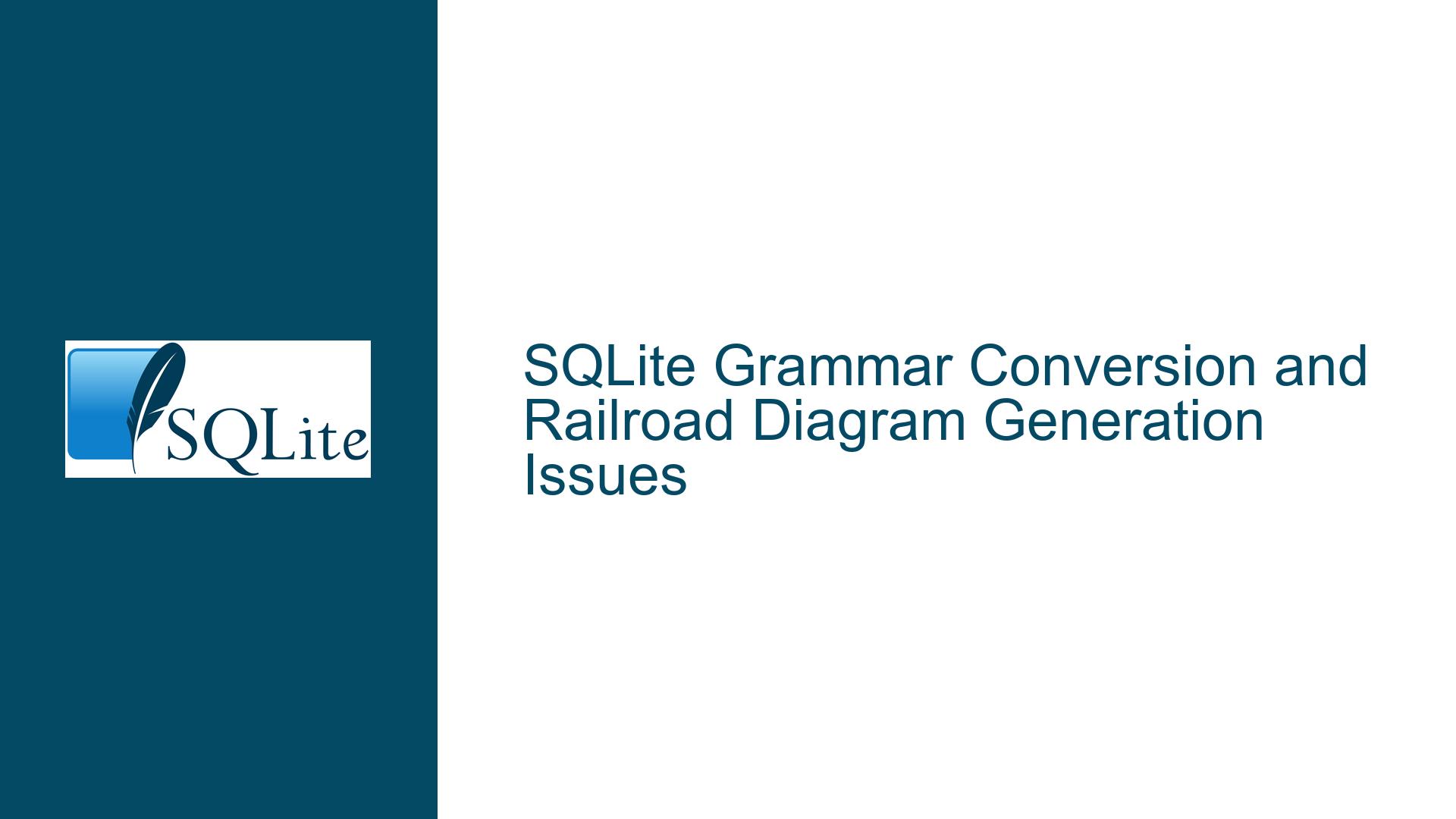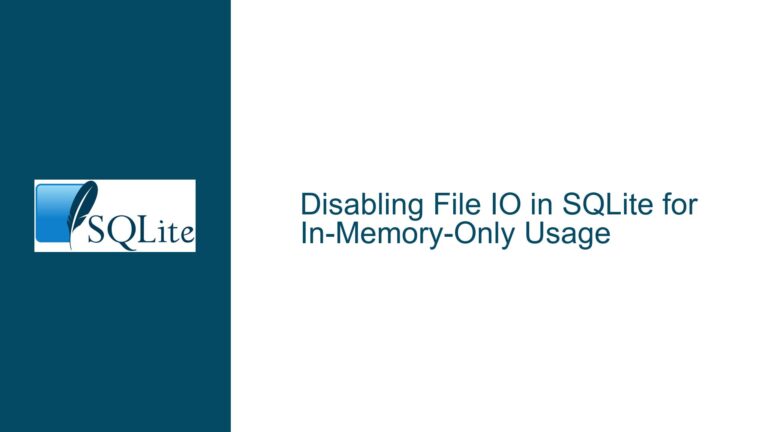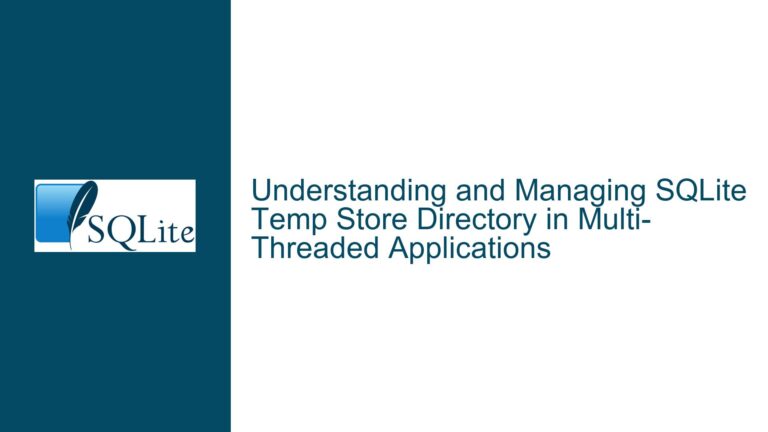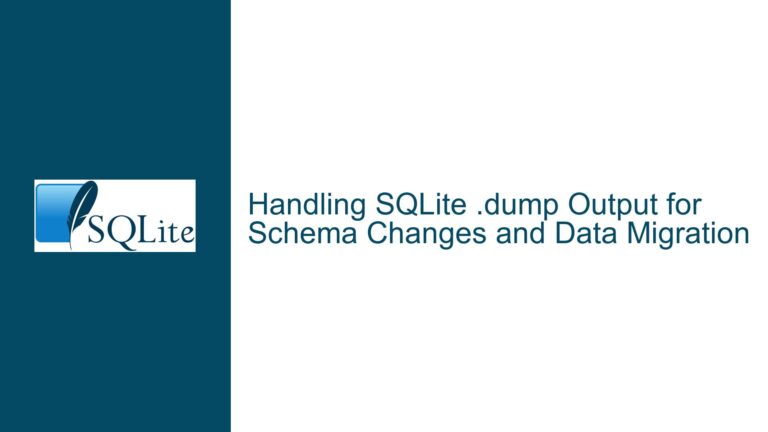SQLite Grammar Conversion and Railroad Diagram Generation Issues
Understanding the Challenges in SQLite Grammar Conversion and Railroad Diagram Generation
The process of converting SQLite’s grammar into a format suitable for generating railroad diagrams involves several intricate steps. These steps include parsing the original grammar file (src/parser.y), cleaning it up, and transforming it into an Extended Backus-Naur Form (EBNF) that can be processed by tools like the one provided by Bottlecaps. While this process seems straightforward, it is fraught with potential pitfalls that can lead to incorrect or incomplete diagrams. Below, we will explore the core issues, their possible causes, and detailed troubleshooting steps to ensure accurate and effective grammar conversion and diagram generation.
The Complexity of SQLite Grammar and Its Impact on Conversion
SQLite’s grammar, as defined in src/parser.y, is a complex and highly structured set of rules that govern the syntax of SQL statements. This grammar is written in a format that is specific to parser generators like Lemon, which is used by SQLite. The grammar includes a mix of token definitions, precedence rules, and production rules, all of which must be carefully handled during conversion.
One of the primary challenges lies in the fact that the grammar file is not purely a grammar definition. It includes additional constructs such as %include, %syntax_error, %stack_overflow, and %destructor, which are specific to the Lemon parser generator. These constructs are not part of the grammar itself but are necessary for the parser’s operation. During conversion, these constructs must be removed or handled appropriately to avoid introducing errors into the EBNF.
Another challenge is the presence of comments and token definitions. Comments in the grammar file are often interspersed with the rules and can interfere with the parsing process if not removed. Similarly, token definitions (e.g., %token, %left, %right) are not part of the grammar rules but are necessary for the parser’s operation. These must also be stripped out during conversion.
The grammar also includes complex rules with nested structures, optional elements, and recursive definitions. For example, the select rule includes multiple optional clauses such as where_opt, groupby_opt, and limit_opt, each of which can contain further nested rules. These structures must be carefully preserved during conversion to ensure that the resulting EBNF accurately reflects the grammar’s semantics.
Potential Causes of Errors in Grammar Conversion and Diagram Generation
The conversion process can fail or produce incorrect results due to several reasons. One common cause is the incomplete or incorrect removal of non-grammar constructs such as %include and %token directives. If these constructs are not properly stripped out, they can interfere with the parsing of the grammar rules, leading to malformed EBNF.
Another potential cause of errors is the mishandling of comments. Comments in the grammar file can be multi-line (enclosed in /* ... */) or single-line (starting with //). If these comments are not fully removed, they can be misinterpreted as part of the grammar rules, leading to incorrect EBNF.
The presence of nested and recursive rules can also cause issues. For example, the select rule includes multiple optional clauses, each of which can contain further nested rules. If these nested structures are not properly handled, the resulting EBNF may not accurately represent the grammar’s semantics, leading to incorrect diagrams.
Additionally, the order of rules in the grammar file can impact the readability of the generated diagrams. The original grammar file may not be organized in a way that is optimal for diagram generation. Reordering the rules can improve the clarity of the diagrams, but this must be done carefully to avoid introducing errors.
Finally, the tool used for generating the railroad diagrams (e.g., the Bottlecaps tool) may have limitations or specific requirements for the input EBNF. If the EBNF does not conform to these requirements, the tool may fail to generate the diagrams or produce incorrect results.
Detailed Troubleshooting Steps, Solutions, and Fixes
To address the challenges and potential causes of errors in grammar conversion and diagram generation, the following steps can be taken:
Preprocessing the Grammar File: The first step is to preprocess the
src/parser.yfile to remove all non-grammar constructs. This includes removing%include,%syntax_error,%stack_overflow,%destructor, and token definitions (%token,%left,%right, etc.). This can be done using a script that employs pattern matching to identify and remove these constructs. For example, the Lua script provided in the discussion usesgsubto remove these constructs.Removing Comments: After preprocessing, the next step is to remove all comments from the grammar file. This includes both multi-line comments (
/* ... */) and single-line comments (// ...). Again, pattern matching can be used to identify and remove these comments. The Lua script in the discussion demonstrates how to do this usinggsub.Extracting Grammar Rules: Once the grammar file has been preprocessed and cleaned, the next step is to extract the actual grammar rules. These rules are typically defined using the
::=operator. The script should parse the file, identify these rules, and store them in a structured format (e.g., a table or dictionary). The Lua script in the discussion usesgmatchto identify and extract these rules.Handling Nested and Recursive Rules: The extracted grammar rules must be carefully handled to preserve their nested and recursive structures. This includes ensuring that optional elements (e.g.,
where_opt,groupby_opt) are correctly represented in the EBNF. The script should also handle recursive rules (e.g.,cmdlist ::= cmdlist ecmd) by ensuring that they are properly formatted in the EBNF.Reordering Rules for Clarity: Once the grammar rules have been extracted and formatted, they can be reordered to improve the clarity of the generated diagrams. This involves grouping related rules together and ensuring that the most important rules are presented first. The Lua script in the discussion demonstrates how to reorder the rules by storing them in a table and then iterating over the table in the desired order.
Generating the EBNF: The final step is to generate the EBNF from the extracted and formatted grammar rules. This involves converting the rules into a format that can be processed by the railroad diagram generation tool. The EBNF should be written to a file or printed to the console, depending on the tool’s requirements. The Lua script in the discussion demonstrates how to generate the EBNF by iterating over the rules and printing them in the correct format.
Validating the EBNF: Before using the EBNF to generate diagrams, it is important to validate it to ensure that it is correct and complete. This can be done by manually reviewing the EBNF or by using a tool that can parse and validate EBNF. Any errors or inconsistencies should be corrected before proceeding.
Generating Railroad Diagrams: Once the EBNF has been validated, it can be used to generate railroad diagrams using a tool like the one provided by Bottlecaps. The EBNF should be pasted into the tool’s input field, and the tool should be used to generate the diagrams. The resulting diagrams should be reviewed to ensure that they accurately represent the grammar.
Iterative Refinement: The process of grammar conversion and diagram generation is often iterative. If the generated diagrams are not accurate or clear, the EBNF may need to be refined. This could involve further preprocessing of the grammar file, reordering of the rules, or adjustments to the EBNF format. The process should be repeated until the diagrams are satisfactory.
By following these steps, the challenges of converting SQLite’s grammar into a format suitable for generating railroad diagrams can be effectively addressed. The key is to carefully preprocess the grammar file, extract and format the grammar rules, and validate the resulting EBNF before generating the diagrams. With careful attention to detail, accurate and clear railroad diagrams can be produced, providing valuable insights into the structure of SQLite’s grammar.






